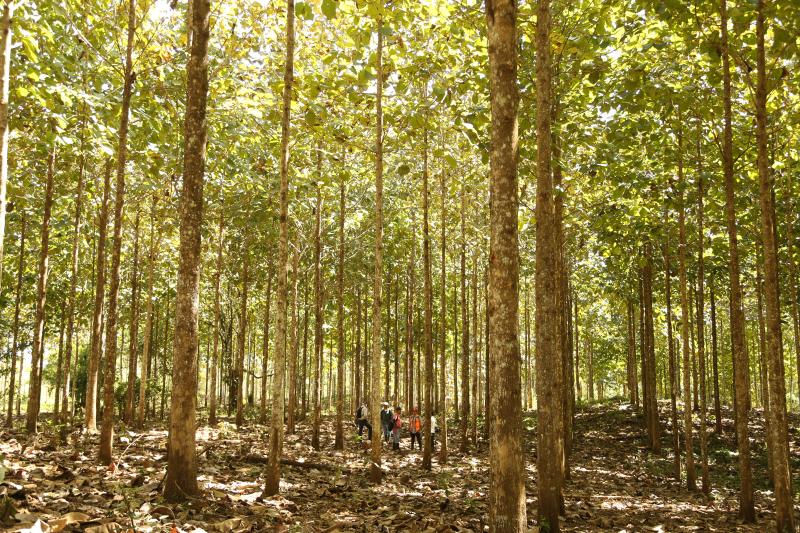How do natural disasters impact forests and climate projects?
November 4, 2024
The green lungs of our planet
Nearly a third of our planet is covered by forests, which play essential roles in preventing desertification, purifying water and air, and storing carbon. Dense forests shield their surroundings from destruction caused by floods and avalanches. Trees and shrub roots stabilise the soil, preventing erosion and preserving the forest's essential functions. Tropical rainforests are especially important, as they are home to roughly 50 percent of the world's animal and plant species.
Forests also play a key role in the fight against the climate crisis. Natural climate solutions, including forest conservation, restoration, and management, can provide a third of the mitigation needed by 2030 to limit warming to the 1.5°C set out by the Paris Agreement.
To enable forests to combat the climate crisis, we must support them: entire regions of trees are dying due to climate change, and deforestation is occurring on a massive scale. Between 2015 and 2020, the worldwide rate of deforestation was estimated to be 10 million hectares per year – more than the size of Portugal.
How natural disasters affect forests
In general, disruptions to the forest ecosystem occur naturally. Droughts, forest fires, insect infestations, and storms are all aspects of complex natural dynamics, which often have positive effects: more resilient plant species are established, biodiversity increases, etc.
However, as climate change progresses, disruptions are occurring much more frequently and, more importantly, with higher severity. Extreme weather events, such as floods, storms, and higher than usual temperatures, have significantly increased in recent decades. In Europe, for example, forests have been dying due to droughts, storms, and insect infestations.
 |
How can climate projects prepare for natural disasters?
Climate projects preserve or create new forests. Afforestation projects create new forests from converted non-forested areas while reforestation projects restore degraded or deforested forests. Also, forest conservation projects establish forest sustainability measures that manage the lives of forests over time.
It is important for project developers to take preventative measures for natural risks at the planning stage. In areas with frequent forest fires, fire-fighting strategies like firebreaks clear out flammable materials, creating a non-combustible area that prevents the spread of fire. Other measures include fire safety and awareness training, which are carried out at regular intervals with project staff and the local population.
Forest resilience and recovery
For a forest to regenerate as quickly as possible after a natural disaster, it must be resilient. Resilience means that the forest can return to its original state and recover after an extreme situation. In reforestation projects, it makes more sense to focus on plant species that are adapted to the climate conditions of the project area. On the other hand, particularly resistant plant species sometimes store less CO2 than other species.
Plant diversity also plays a part in this context: monocultures are generally less resilient than mixed forests and more susceptible to pests and diseases, which can lead to soil erosion. With reforestation projects in particular, the choice of plant species can minimise the impact of natural disasters.
Buffer pools cover the risk of natural disasters
Natural disasters are disruptive when it comes to saving emissions: a climate project should save CO2 emissions and prove this with verified emission reductions (VERs) traded on the voluntary carbon market (VCM); but also, a forest can burn down or be destroyed and hence release CO2 emissions. So, how can these fit together?
Risks such as extreme weather events must be included in climate projects from the start to ensure the long-term viability of a project and be registered with an internationally recognised standard. Project developers conduct a risk analysis before the project begins, which assesses natural disasters.
This analysis is the basis for determining how many VERs are set aside in a "buffer pool", which is a reserve or stockpile in case fires or storms occur. The emission reductions from this buffer pool are set aside if a risk arises and not allowed to be sold. If, for example, a project has released more emissions than it has saved due to a fire, buffer pools serve as damage compensation. In this case, emission reductions are taken from the buffer pool and excluded from sale.
If a project has still generated emission reductions after deducting the damage, these VERs can be traded and purchased on the VCM. The buffer pool mechanism therefore ensures that damage from natural disasters is fully taken into consideration.
In addition, the standard provider obliges the project developer to report damages transparently and, if necessary, take measures to reduce future damages. Independent auditors who verify the project over a period of at least five years can also demand that future monitoring reports are adjusted accordingly.
Climate projects support local communities
Extreme weather events occur frequently in South Asia and Sub-Saharan Africa, where many climate projects are located. If a forest protection or reforestation project is affected by a natural disaster, it also has an impact on the local population. When companies stop funding these projects due to uncertainty, it impacts the livelihoods of many communities, as climate projects are often an important source of income and help mitigate the effects of natural disaster. For instance, mangrove forests, which are unique ecosystems made up of trees and shrubs that grow on the coastal intertidal zone, protect coasts from storm surges and flooding thanks to their dense roots.
The costs from flooding and other extreme weather events greatly exceed the investment needed to prevent against their increasingly more destructive effects. Communities that do not have the resources to mitigate these natural disasters are particularly vulnerable to these consequences. That is why it is so important to contribute to the financing of climate projects.
Are you interested in protecting forests and supporting climate projects?